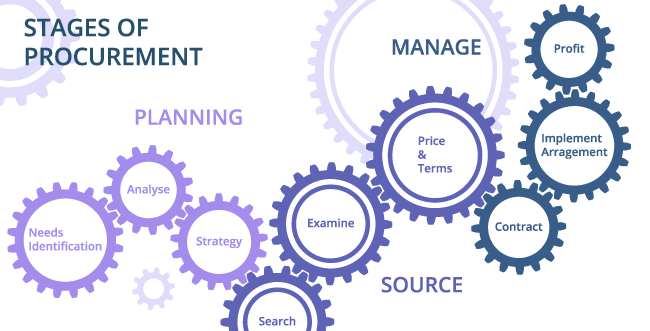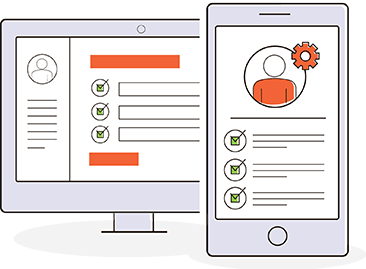Procurement Process Explained
Procurement Process Workflow Automation Delivers Critical Business Advantages
 Procurement Process Definition – What Is the Procurement Process?
Procurement Process Definition – What Is the Procurement Process?
The procurement process describes how a company makes necessary purchases of materials and services to facilitate its continued operation. It involves the specific identification of those needs, a detailed examination of options, and all successive steps necessary to find and obtain the required goods and services. For more on the definition of procurement, visit Investopedia.
As a primary goal of any business should be to reduce inefficiency and wasteful spending, a robust procurement management plan can ensure that the purchasing process is efficient. The use of procurement management software and systems to facilitate procurement automation can help in this process by creating healthy, streamlined procurement workflows.
A procurement workflow is a series of tasks related to the procurement process, including the business rules and integrations required to move work and data across the organization. Basic workflow steps in the procurement process include:
- Uncover Need
- Identify Source
- Request Purchase
- Generate Order
- Receive Invoice
- Pay Vendor
Procurement Is a Process
Although the words are sometimes used interchangeably, procurement is the preferred umbrella term that involves sourcing, acquisition, or purchasing. Viewing the process as an integrated and elemental function of a company's decision-making structure offers a sense of its importance and relevance in any corporate hierarchy. Procurement workflow refers not only to needs identification but also to the methods used for needs fulfillment and the tracking and documentation of required purchases by the procurement function.
In addition, procurement can benefit from a periodic performance assessment like any other business process. This can be done through formal process improvement efforts.
 To best manage and integrate the procurement process, smart finance professionals are turning to process automation as their procurement management system.
To best manage and integrate the procurement process, smart finance professionals are turning to process automation as their procurement management system.
Ideally, the procurement management process identifies the products, services, personnel, raw materials, software, hardware and finished "widgets" that secure a company's position in the market and allow it to achieve desirable goals.
Strategic Procurement Management: A Multi-faceted Effort
Procurement often involves competitive bidding, but not always. The procurement process is influenced and sometimes complicated by other business procedures, and varied means might be employed to source and secure differing products or services. The process can be relatively routine if a company employs purchase orders or purchase requisition forms for purchase requests, but purchase decisions must also account for cost variations and scarcity.
An effective procurement management plan requires strategic planning, careful monitoring, and thorough follow-up. Procurement is the basic building block that determines a company's ability to secure necessary assets on time and for the right price. The actual act of purchasing is just one factor. In addition, procurement typically involves the negotiation necessary to draft contract terms, including quality specifications, pricing, and delivery, that are acceptable to all parties involved.
In modern business, procurement efforts focus on achieving tactical goals at the lowest possible price. It's an important focus that requires a comprehensive approach and multi-faceted expertise.
Procurement Process Steps

By understanding the basic steps required for an effective procurement workflow and by identifying key considerations, a business can implement strategic steps to achieve maximum cost savings. The goal should be to ensure that the total design of the process—from the initial identification of needs to final record-keeping—is seamlessly implemented.
Think of the procurement cycle as a sort of ladder: Climbing that ladder requires these seven steps:
- Recognizing a Need/Defining Need Specifics
- Identifying Sources
- Researching Pricing and Terms
- Specifying Orders
- Arranging Delivery/Assuring Timeliness
- Confirming Orders and Receiving Purchases
- Approving and Arranging Payment
Procurement can be simple or complex, depending on the type of business, and the procurement team may comprise only one or two individuals or an extensive and specialized department. However, the steps involved in the procurement cycle are essentially the same, whether for a Mom and Pop organization or a multi-million-dollar enterprise.
Skipping a single step can endanger the entire process. The process, of course, is ongoing and must be managed appropriately. Adequate checks and balances must be implemented to control costs and cash flow, regulate orders and stock, catalog inventory, and account for the proper utilization of secured goods and services. However, these concerns do not necessarily fall under the jurisdiction of the procurement team.
Potential Risks a Procurement Management Plan Must Address
As with any business endeavor, certain risks are inherent in the supply chain. Among the most serious are corruption and fraud. Maintaining competitive practices when identifying sources and securing bids and contracts can minimize any risks associated with unregulated sourcing. Transparency throughout the successive steps of the procurement cycle should alleviate major risk. Periodic audits are beneficial, and semi-annual or annual review of procedures are recommended.
Financial discrepancies will affect a company's bottom line, but with proper oversight and control, any procurement issues can be identified and remedied before they become major problems. Specialty software programs are invaluable for tracking and minimizing potential abuse.
Maximizing Procurement Process Benefits

Within a compartmentalized organization, the procurement process flow is a key component of business success and must be integrated with other departments, specifically production and sales efforts. Optimal efficiency is only possible if procurement efforts are intertwined with overall goals and objectives.
In today's fast-paced business environment, that is only possible with some degree of workflow automation. For most business firms, the days are long gone when decision-making can evolve without the help of technology. Procurement automation minimizes human error and saves time, increasing the cost-saving benefits of a proper procurement management plan.
To improve and perhaps broaden your firm's procurement practices, there are several key elements of the process to explore.
Strengthening Vendor Relationships for Better Procurement Management
A procurement team must necessarily look both inward and outward to function successfully. Building solid relationships with vendors and better vendor management will make the sourcing and purchasing tasks easier and favorably impact the bottom line. Team-building efforts promote loyalty and are always beneficial.
Institute Contract Management and Order Renewal Systems for Procurement Automation
Simplify and automate wherever possible, particularly when repeat orders for goods and services are involved. Explore the benefits and possibilities of automated processes, and expedite the process with specially-designed workflow software that supports your organization's unique needs.
Build Analytical and Negotiating Skills
Equip your team with the skills-training tools that will allow them to develop competency, gain expertise and confidently pursue your company's procurement goals. The time, effort and money will be well spent; consider such programs an investment in your company's future.
Focus on Internal Communications
Although interdepartmental cooperation is sometimes considered a given, it can be instructive for other departments to understand and support the company's procurement team. Integrating procurement efforts with other objectives will help build a more cohesive business environment and produce a better return on investment in both human and financial terms.
Other Procurement Resources
- 6 Essential Steps in the Procurement Process Flow
- Procurement Business Essentials
- Procurement Software Directory
Integrify Can Handle Your Procurement Workflow
Interested in Automating Your Procurement Process?
We have a variety of resources to help you on your journey to an automated procurement workflow.


